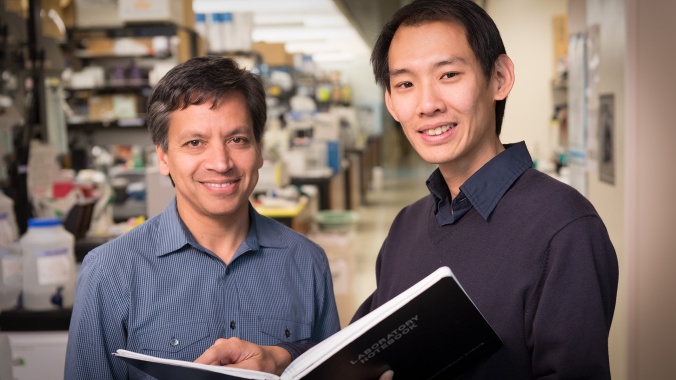Although heart muscle cells, or cardiomyocytes, are specialized to help pump blood to the organs, they nonetheless carry all the genetic instructions for becoming a nerve cell, an intestinal cell, a liver or any cell type in the body. But at the moment in time that the fetal heart begins to develop, master switch proteins, called transcription factors, act like the first tile in an extremely complex pattern of dominos and set off a chain of events which lead to the activation of heart muscle specific genes in cardiomyocytes as well as the silencing of genes important for the development other cells types.

cardiomyocytes
It’s truly amazing that this process comes together to create functioning hearts in the about 355,000 babies that are born in the world each day. But it isn’t always flawless as heart defects occur in about 1% of all live births. By studying a family with a history of heart defects, scientists at the Gladstone Institutes have gained a deeper understanding of how gene networks go awry, causing heart defects as well as heart disease later in life. This CIRM-funded work was published today in Cell.
Half the children in the family studied by the Gladstone team were born with a hole in the wall between the two chambers of the heart. Back in 2003, the family approached Deepak Srivastava, head of the cardiovascular institute at Gladstone, for help. A genetic analysis by Srivastava’s team found that all of the affected children carried a mutation in the GATA4 gene, which encodes a heart specific transcription factor protein. Seven years later the children developed heart disease that led to weaker heart pumping. Although the two heart problems were not related, they suspected both were caused by the GATA4 mutation and sought to understand how that could be the case.
Srivastava’s team sought to understand how the GATA4 mutation could be causing both health problems. They collected skin samples from the affected children and generated cardiomyocytes using the induced pluripotent stem cell technique. Cells were also collected from the children’s healthy siblings. In the laboratory, the cells were analyzed for how well they functioned, such as their ability to contract. All of these tests showed that the cells carrying the GATA4 mutation had impaired function compared to the healthy cells. These findings provide a basis for the heart disease found in the children during their teens.
In terms of the heart wall defect, the team examined the GATA4 protein’s interaction with the protein TBX5, another transcription factor that is also mutated in cases of this defect. Both proteins regulate genes by directly binding to DNA as well as interacting with each other. In cells with the defective GATA4, the research discovered TBX5 did not bind well to the DNA. The lack of TBX5 led to a disruption in the activation of genes that play a role in the development of the heart wall.
TBX5 and GATA4 also work together in cardiomyocytes to silence genes that play a role in other cell types. But the scientists found that the because the GATA4 mutation hindered its interaction with TBX5, those non-heart specific genes we’re no longer repressed causing further disruption to proper cardiomyocyte development. Srivastava summed up these results in an institute press release:
Deepak Srivastava
“By studying the patients’ heart cells in a dish, we were able to figure out why their hearts were not pumping properly. Investigating their genetic mutation revealed a whole network of genes that went awry, first causing septal [heart wall] defects and then the heart muscle dysfunction.”
Now, because GATA4 and TBX5 are those first domino tiles in very intricate networks of genes, targeting those proteins for future therapy development wouldn’t be wise. Their effects are so widespread that blocking their actions would do more harm than good. But finding drugs that might affect only a branch of GATA4/TBX5 actions could result in new therapy approaches to heart defects and disease.
 Deepak Srivastava and Yen-Sin Ang [Photo: Chris Goodfellow, Gladstone Institutes]
Deepak Srivastava and Yen-Sin Ang [Photo: Chris Goodfellow, Gladstone Institutes]
Yen-Sin Ang, the first author on the report, thinks these finding could prove fruitful for other diseases as well:
“It’s amazing that by studying genes in a two-dimensional cluster of heart cells, we were able to discover insights into a disease that affects a complicated three-dimensional organ. We think this conceptual framework could be used to study other diseases caused by mutations in proteins that serve as master regulators of whole gene networks.”
